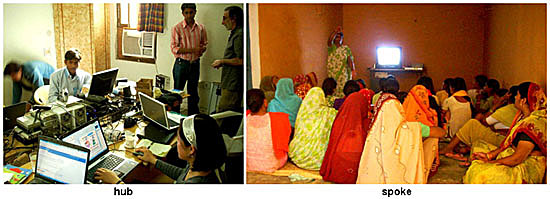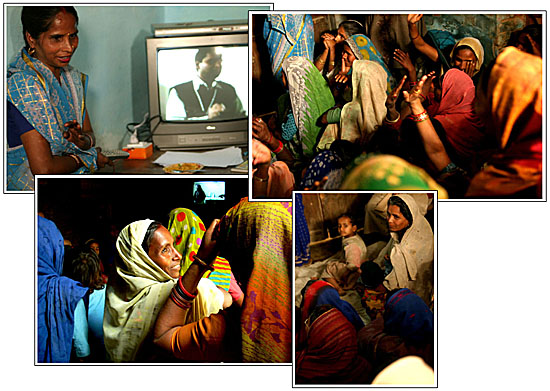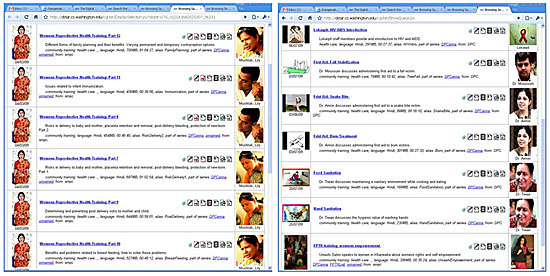Digital Polyclinic: How Does It Work?
We have been piloting a community video sharing project in rural India aimed at spreading health-related knowledge. We partner with hospitals and NGOs that have had an extensive track record of running rural outreach programs; organize workshops and demonstration meetings with experienced local experts (such as doctors, nurses, and other public health workers) in local communities; film the presentations and discussions; organize the resulting videos in a digital database; burn selected programs onto DVDs; identify and train local leaders to be "mediators"--villagers with good communication and literacy skills who are tasked with regularly pausing the videos during screening to constantly question or otherwise interact with the audience; provide cheap and practical equipment for screening (TVs, DVD players, inverters and batteries charged in electrified locations and brought to the screening sites); and organize screening tours in targeted rural areas.
The idea of community-based video sharing is obviously not new; YouTube is perhaps the most prominent example. We now discuss how our project is different. And, indeed, it's the synergy of the following aspects that's of greatest importance.

The first is our choice of cheap and practical technologies. Computers and broadband networks are not practical in the areas that we serve. They are expensive, difficult to use, hard to fix when broken; besides, the data network coverage is poor. TVs and DVD players are cheap and easy to learn and use in the field (or what we call "spokes"). While it is true that we still need computer equipment during the video digitizing, editing, and database management processes, such equipment is only used in a small number of "production hubs," manned by more skilled staff. And unlike professional-grade equipment employed by TV studios and the like, the use of common off-the-shelf camcorders and regular PCs means that it's feasible and cost-effective to scale up these hubs. This "hub-and-spoke" model, consisting of hubs made of modest tech and spokes made of low tech, allows us to imitate an Internet-based video sharing system without demanding the traditional Internet infrastructure.

The second innovation is our pedagogical methodology, what we call the "mediation-based" approach. This has been a model that we have used successfully in our larger Digital StudyHall (DSH) education effort. What we have learned is that one cannot just play the TV and expect passive watchers to effectively learn. Instead, we require a local "mediator," whose job is to frequently pause the videos, engage and interact with the audience. This pro-active ingredient is critical in getting the message across. This approach kills two birds with one stone: it addresses the fidelity-loss issue discussed earlier because the on-screen expert is in good command of the subject matter and a coherent "lesson plan;" it also addresses local capacity building as the local mediator becomes over time increasingly knowledgeable, more fluent in delivery, and more empowered.

The third important aspect is the community-based content-generation approach. We have already discussed the requirements of local relevance that are rarely met by distant outside experts; we now give another example, the language issue. There are twenty-two major languages in India, each of which spoken by more than one million people. Furthermore, although vast swaths of India speak Hindi, there are many distinct dialects--indeed, there's a big difference between "city Hindi" and "village Hindi," and a middle-class doctor who has no experience with the rural settings is likely to find himself like a fish out of water. In contrast, the local experts that we put on film are well-versed in such nuances and they have learned to be effective communicators through years of field experience.

The fourth important aspect is our relying on video as the main delivery medium. Brochures, pamphlets, posters are not as effective in a low-literacy environment and they lack expressiveness. Videos are easy and cheap to make and they can effectively capture and convey the "performance" aspect of a good communicator. It's nimble, easily deployable in the field--indeed, we have found that footages shot in the field are often more engaging than those shot in an anonymous room (even when the said room is in a rural clinic). Our project also covers important issues that are not strictly health-related, such as women's rights, alcohol abuse (by husbands), and girl child's education. Our ambition for the future is to produce an "encyclopedic" video library that covers all major languages, easily accessible by the next-generation technologies that are already on the horizon.